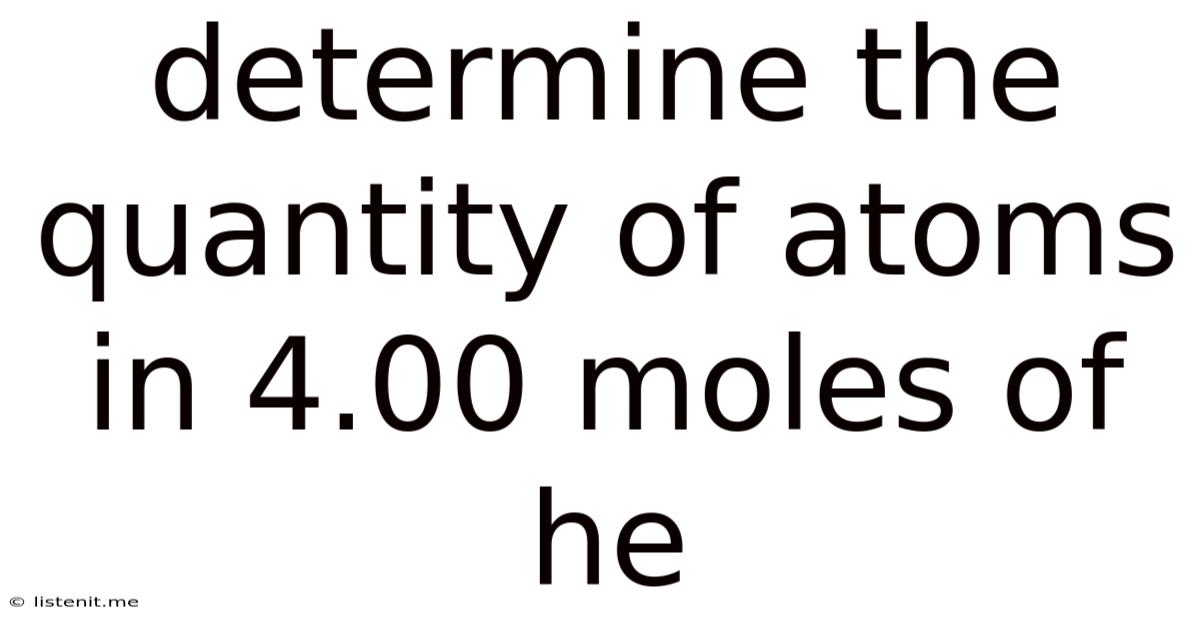Determine The Quantity Of Atoms In 4.00 Moles Of He
listenit
May 12, 2025 · 5 min read

Table of Contents
Determining the Quantity of Atoms in 4.00 Moles of He: A Deep Dive into Avogadro's Number
Understanding the relationship between moles, atoms, and Avogadro's number is fundamental to chemistry. This article will delve into the process of calculating the number of atoms in 4.00 moles of helium (He), explaining the underlying concepts and providing a step-by-step guide. We'll also explore the significance of Avogadro's number and its applications beyond this specific calculation.
Understanding Moles and Avogadro's Number
Before we tackle the calculation, let's clarify the key concepts:
What is a Mole?
A mole (mol) is a fundamental unit in chemistry that represents a specific number of particles, be they atoms, molecules, ions, or other entities. It's essentially a counting unit, much like a dozen represents 12 items. However, a mole is significantly larger, containing 6.022 x 10<sup>23</sup> particles. This enormous number is known as Avogadro's number (N<sub>A</sub>).
The Significance of Avogadro's Number
Avogadro's number is a cornerstone of chemistry. It provides a bridge between the macroscopic world (the quantities we can measure in the lab) and the microscopic world (the individual atoms and molecules). It allows us to relate the mass of a substance to the number of particles it contains.
This number wasn't arbitrarily chosen; it's derived from the relationship between the atomic mass unit (amu) and the gram. One amu is approximately the mass of a single proton or neutron. Avogadro's number ensures that one mole of any element has a mass in grams numerically equal to its atomic mass. For example, one mole of carbon-12 (atomic mass 12 amu) has a mass of 12 grams.
Connecting Moles, Atoms, and Avogadro's Number
The crucial relationship we need for our calculation is:
Number of atoms = Number of moles x Avogadro's number
This equation tells us that the total number of atoms is directly proportional to the number of moles. The more moles we have, the more atoms are present. Avogadro's number acts as the conversion factor between these two quantities.
Calculating the Number of Atoms in 4.00 Moles of Helium
Now, let's apply this knowledge to calculate the number of atoms in 4.00 moles of helium:
1. Identify the known quantities:
- Number of moles (n) = 4.00 mol
- Avogadro's number (N<sub>A</sub>) = 6.022 x 10<sup>23</sup> atoms/mol
2. Apply the formula:
Number of atoms = n x N<sub>A</sub>
3. Substitute the values:
Number of atoms = 4.00 mol x 6.022 x 10<sup>23</sup> atoms/mol
4. Perform the calculation:
Number of atoms = 2.4088 x 10<sup>24</sup> atoms
Therefore, there are approximately 2.41 x 10<sup>24</sup> atoms in 4.00 moles of helium. We've rounded the final answer to three significant figures to maintain consistency with the given number of moles.
Beyond the Calculation: Applications of Avogadro's Number and Molar Mass
The ability to convert between moles and the number of atoms (or molecules) is vital in various chemical calculations and applications:
1. Determining Molar Mass
The molar mass of an element is the mass of one mole of that element, expressed in grams per mole (g/mol). It's numerically equal to the element's atomic mass on the periodic table. For helium, the molar mass is approximately 4.00 g/mol. This allows us to easily convert between the mass of a sample and the number of moles, and subsequently, the number of atoms.
2. Stoichiometric Calculations
Stoichiometry deals with the quantitative relationships between reactants and products in chemical reactions. Avogadro's number is essential for balancing chemical equations and performing stoichiometric calculations, allowing us to determine the amounts of reactants needed or products formed.
3. Gas Laws
Avogadro's Law states that equal volumes of different gases at the same temperature and pressure contain the same number of molecules. This law, directly related to Avogadro's number, is crucial in understanding the behavior of gases.
4. Solution Chemistry
In solution chemistry, molarity (moles of solute per liter of solution) is a common concentration unit. Avogadro's number helps us relate the molarity of a solution to the number of solute particles present.
5. Nuclear Chemistry
In nuclear chemistry, Avogadro's number is used to calculate the number of radioactive atoms in a sample and to determine the rate of radioactive decay.
Practical Applications and Real-World Examples
The concepts discussed here aren't confined to theoretical calculations. They have numerous practical applications across various fields:
-
Manufacturing: Precise control over the number of atoms or molecules is crucial in manufacturing processes, particularly in materials science and pharmaceuticals.
-
Medicine: Understanding molarity and dosages is essential in pharmacology and drug delivery.
-
Environmental Science: Calculating the amount of pollutants in the environment relies on understanding molar quantities and concentrations.
-
Forensic Science: Analyzing trace amounts of substances often involves calculations based on moles and Avogadro's number.
Conclusion
Calculating the number of atoms in 4.00 moles of helium is a straightforward application of Avogadro's number. However, the underlying principles and the broader applications of this concept extend far beyond this single calculation. Mastering the relationship between moles, atoms, and Avogadro's number is fundamental to understanding and working with chemical quantities in various contexts. From stoichiometry and gas laws to solution chemistry and nuclear chemistry, this fundamental concept serves as a cornerstone of numerous chemical calculations and applications in various fields. The ability to seamlessly convert between moles and the number of particles underscores the importance of Avogadro's number in the world of chemistry and beyond.
Latest Posts
Related Post
Thank you for visiting our website which covers about Determine The Quantity Of Atoms In 4.00 Moles Of He . We hope the information provided has been useful to you. Feel free to contact us if you have any questions or need further assistance. See you next time and don't miss to bookmark.